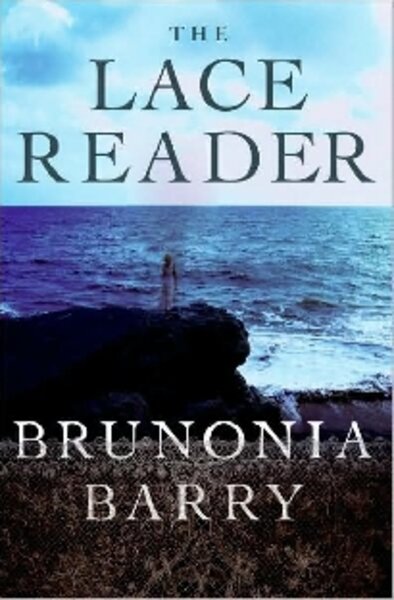The Lace Reader
Loading...
Folks, don’t mess with a woman wielding needles. If Charles Dickens hadn’t made this perfectly plain in “A Tale of Two Cities,” Brunonia Barry hammers the point home in her new novel, The Lace Reader, which features the most high-concept use of needle work since Madame Defarge and her knitted register.
Salem resident Barry is that rarest of creatures: a bona fide self-publishing success. Her debut novel for adults, “The Lace Reader,” attracted so much buzz she scored a seven-figure deal with William Morrow. The combination of do-it-yourself grit and a page-turning plot should make her popular with book clubs and knitting circles alike.
That plot – which incorporates women’s issues, a dead twin, sailing, a cult, spiritualism, insanity, reincarnation, underground tunnels, and a witch hunt involving an actual mob carrying actual torches – is crammed fuller than the carry-on bag of a Delta Airlines passenger. And it all hinges on one doozy of a reveal that upends everything that came before.
Surprise endings are tough to pull off – too often they aren’t a surprise to anyone but the main character. To Barry’s credit, she genuinely got me. But the big finish leaves all of the characters’ interactions in question and their futures unresolved. This is no doubt intentional, since Barry is apparently planning a trilogy. (Although one has to wonder, what’s left?)
Towner Whitney fled Salem, Mass., after the death of her twin at 18. As she explains to a reader, after Lyndley’s death, she spent time in a mental institution, where she volunteered for shock therapy, leaving her with few memories of her childhood, even fewer of them good.
Now 32, she’s returned because her beloved Aunt Eva, an etiquette teacher and Salem’s original lace reader, has disappeared. Waiting for Towner on the family-owned Yellow Dog Island are the other Whitney women: May, an agoraphobic who runs a lacemaking collective for abused women, and Emma, who was blinded by her abusive husband – the man who Towner says abused her twin.
“Never believe me. I lie all the time,” Towner tells readers on the first page. “I am a crazy woman.... That last part is true.” A reader would do well to read those sentences several times before proceeding and, whenever things don’t make sense, flip back and read them again.
All the Whitney women can read lace (as opposed to tea leaves), although Towner hasn’t done it since she was a teenager.
“I don’t know why anyone would want to do this for a living, telling people’s fortunes,” Towner says. “It would make me so sad.” The art of lace-reading, as devised and explained by Barry, is simple: You take a doily (handmade – none of that machine-made stuff), squint into the pattern, and look for pictures.
Either this will strike a reader as a lovely metaphor or overly quaint. I, unfortunately, fall into the latter camp. Smack me with a tea cosy and dunk me in chamomile, but it’s just a little too twee for me.
To balance that, Barry offers an insider’s tour of “Witch City” (with some hysterical townie jokes) and a plot that, under all the lace and mysticism, is a dark tale of abuse. Parallels between the Salem witch hunts of the 17th century and domestic violence today are personified by Cal Boynton, Emma’s ex-husband. (Such parallels won’t be news to anyone with a passing familiarity of feminism.)
Claiming to have repented in a road-to-Damascus-type conversion, Cal now runs a cult that, among other services, offers exorcisms of teenagers every Thursday. (As one character remarks, what parent doesn’t suspect his teen is possessed?) Cal and his followers also have been trying to relive history by bringing charges of witchcraft against Eva and other women. Towner and a local detective believe Cal is behind the disappearance of both Eva and a missing teenage girl.
Barry has different narrators take sections of the novel, with varying degrees of success. Most engrossing are the journal entries and short story that Towner wrote during her stay at the mental institution describing what she remembers of her teenage summers with Lyndley. Eva, with her Transcendentalism and comforting clichés, is a lovely creation, and prickly May, with her Underground Railroad for abused women, also captures the imagination. A personal favorite is Ann Chase, Salem’s most famous witch, who has a talent for phrenology and for disarming nasty men with high school Latin. The men are less finely drawn.
Barry’s knowledge of the town’s history is extensive and one of the chief strengths of “The Lace Reader.” The climax, however, involving an underground, underwater escape from the aforementioned torch-wielding mob, bears little resemblance to the Salem I once lived near.
But as anyone who’s visited knows, the town seems perfectly happy to capitalize on both its haunted and literary pasts. With a prefabricated cottage industry (the marketing materials actually include a “How to Read Lace” kit), Barry seems poised to add her own twist to local tourism.
Let me make my own prediction: If I show up to find a huckster squinting into a lace hanky, I’m going to bop him with a rolled-up doily.
Yvonne Zipp regularly reviews fiction for the Monitor.






